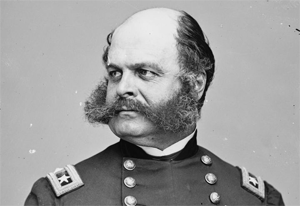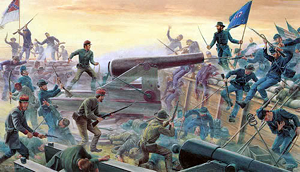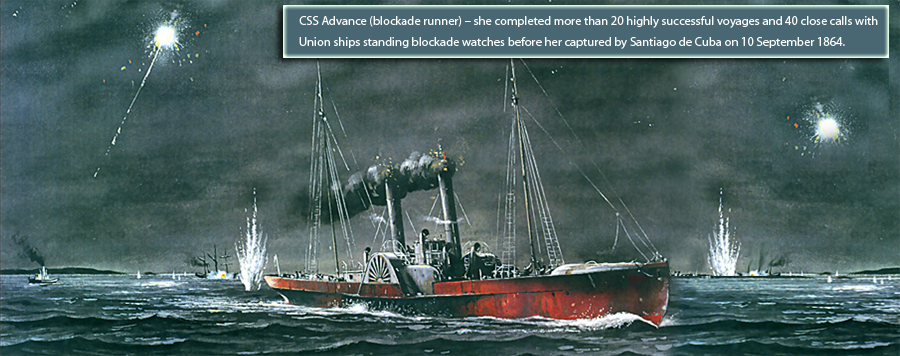
Brigadier General Ambrose E. Burnside

Ambrose Everett Burnside Union Officer, after the war served as a railroad executive, inventor, industrialist, and politician, was the first president of the NRA, serve as a U.S. Senator and governor of Rhode Island. As a Union Army general in the American Civil War, he conducted successful campaigns in North Carolina and East Tennessee, but resigned his commission in wake of the disastrous Battle of Fredericksburg and Battle of the Crater. His distinctive style of facial hair is now known as sideburns, derived from his last name..

Burnside Expedition
Also known as the Burnside NorthCarolina Expedition was a series of engagements fought along the North Carolina Coast between February and June 1862. The expedition was part of Winfield Scott’s overall Anaconda Plan, which aimed at closing blockade-running ports inside the Outer Banks. The amphibious operation was carried out primarily by New England troops under BG Burnside and assisted by the North Atlantic Blockading Squadron under Captain Louis M. Goldsborough.

Ironclad - CSS Neuse
Completed in June 1864, was involved in a small action before being sidelined for rest of the war in Kintson, NC. Scuttle during the Wyse Fork Battle in March 1865 to avoid capture by the Union Army. This is the remains of the orginal CSS Neuse. It is being presently moved indoors to a new Caswell museum in downtown Kinston to prevent further detoriation.
Civil War on the Outer Banks 1861-1865
The Atlantic coast of North Carolina is protected for much of its length by a series of barrier islands. Control of these islands and the bodies of water west of them known as "sounds" was crucial for both sides. Early in the war Union forces moved to occupy the islands in order to choke off Southern-friendly shipping and control the deep-water rivers that fed the sounds. Losing the coast put most of Confederate eastern North Carolina in danger and threatened the critically important supply line on the Wilmington and Weldon Railroad.
Realizing the importance of eastern North Carolina, Union Gen. Ben Butler launched an amphibious attack against Confederate-manned forts located at the southern tip of Hatteras Island. The forts fell Aug. 29, 1861. A similar Union attack in February 1862 toppled Confederate defenses on the strategically located Roanoke Island. The Roanoke expedition, planned and led by Gen. Ambrose Burnside, resulted in Union control of several of the sounds and coastal rivers.
A little more than a month later, on March 14, 1862, New Bern fell. Federal troops used the town as a base for the remainder of the war. Fort Macon, a brick structure guarding the approach to Beaufort, was surrendered by the Confederates April 25.
The loss of most of the North Carolina coast and coastal waterways was a blow both to Confederate morale and the young nation's ability to supply its armies in the field. By late spring 1862, Union soldiers occupied the towns of Plymouth, Washington and New Bern. But aside from a few raids from those bases, the Union forces went no farther until the very end of the war when Sherman entered North Carolina in March–April 1865.
The one bright spot for the Confederates along the coast was Wilmington. Protected by strong fortifications at the mouth of the Cape Fear River, the port remained open, shipping supplies to Lee's army in Virginia until the forts fell in early 1865.
Burnside Expedition
A major force use extensively in early 1862 by the Union to capture and control the sounds and waterways of North Carolina was the Burnside Expedition, led by Brigadier General Ambrose E. Burnside and accompanied by armed vessels from the North Atlantic Blockading Squadron. Operated from January to June 1862 in which this group was successful in taking the most major fortifications on the North Carolina inlands located in the Ablemarle and Palmico Sounds. His unit was responible for the Union victories at Roanoke Island, Elizabeth City, South Mills, New Bern, Fort Macon, and Tranter's Creek.
The use of the Ironclads in the Outer Banks
The use of the Ironclads became very important when it came to controling the waterways and sounds of the Outer Banks. With each battle the use of ironclad and gunboats determine if the outcome could be won or lost. With the loss of the CSS Ablemarle, Plymouh quickly fell back into the hands of the Union. Also without use of CSS Neuse, the battle for New Bern was bound to fail. See our section on Ironclads to read the full story of the history of the ironclads in North Carolina.

Blockade Runners
During the American Civil War, blockade running became a major enterprise for the Confederacy due to the Union's Anaconda Plan, which sought to cut off all the Confederacy's overseas trade. Twelve major ports and approximately 3,500 miles of coastline along the Confederate States were patrolled by some 500 ships that were commissioned by the Union government. Great Britain played a major role on the blockade running business, as they had huge investments in the south and were the recipients of many commodities exported goods, especially cotton. To protect their interests British investors had engineered steamships that were longer, narrower and considerably faster than most of the conventional steamers guarding the American coastline, thus enabling them to outmaneuver and outrun Union ships on blockade patrol. Among the more notable of these premier vessels was the CSS Advance that completed more than 20 successful runs through the Union blockade before being captured.
